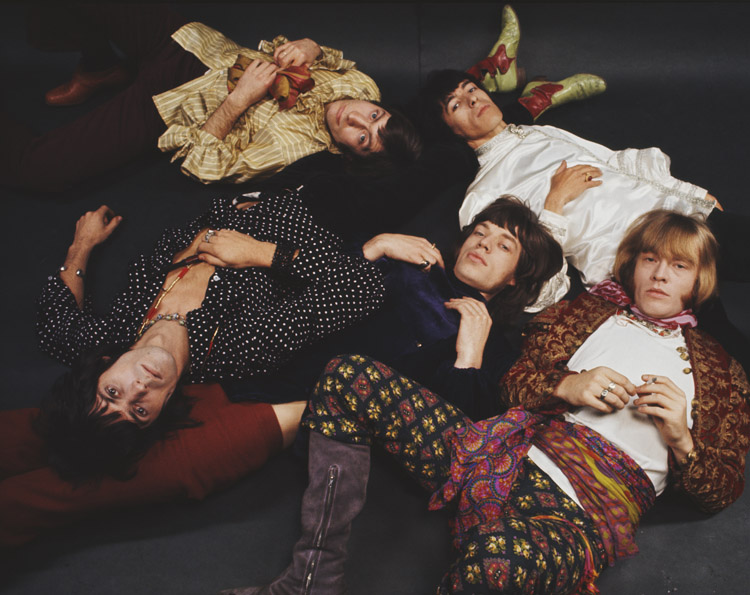
Fifty years ago the Rolling Stones started one of the most amazing comebacks in rock history. By the end of 1967 the British had reached an artistic dead end with "Their Satanic Majesties Request", and their last big hits were a while back. Consequently, at the beginning of 1968 Jagger & Co. were regarded as a discontinued model - nonsense, as soon became apparent. In the following, we trace the process of creating "Beggars Banquet", the album with which the group regained their manginess.
It was the gardener. The man, his name was Jack Dyer, hadn't thought anything of it. Redlands, West Wittering in the county of West Sussex, late winter, it must have been February 1968: Mick Jagger and Keith Richards, both 24, have spent the night in Richards' thatched half-timbered house just a few stone's throw from the sea. At dawn, Jagger has already dozed off, the gardener's footsteps can be heard from outside. In rubber boots he trudges through the rainy ground. Jagger drives up and asks the landlord what kind of noise it was. Richards: "Oh, this is Jack - jumpin' Jack."
Dyer's footsteps have sown a seed this gloomy morning - the seed for a new Rolling Stones song and one of the most amazing comebacks in the annals of popular music.
Annus horribilis
As pleasing as the hippie year 1967 had started for the Rolling Stones at first, it developed into the Annus horribilis: In January the single "Let's Spend The Night Together/Ruby Tuesday" was released, plus the new album "Between The Buttons". Both records reached top positions in the charts on both sides of the Atlantic, "Ruby Tuesday" even climbed to number one in the USA. Back in England, however, trouble was brewing. On February 12, Redlands was the scene of the infamous raid that led to the first major drug trial in the rock scene this summer. Jagger and Richards had to go to jail for a short time, but finally got away with probation. Also Brian Jones was arrested several times and quoted before the judge. Gradually the sensitive band founder began to break up because of his excessive rock star life. In autumn, psychiatrists described him as a "very frightened young man with suicidal tendencies". The fact that Richards had also taken his girlfriend Anita Pallenberg away from him during a joint trip to Morocco in February did not make things any easier. On the European tour in spring Richards and Jones also stayed in different hotels, the house blessing at the Stones hung crooked like never before. This also affected manager Andrew Loog Oldham, his relationship with the band was shattered. In summer, they broke up for good. Under these circumstances, efficient and concentrated work was hardly conceivable. The sessions for a new album at the Olympic Studios were poorly organized, no one was able to take control of the artistic process, and no one knew who would appear for the next recording, possibly stand in court or even be in jail. The hastily released summer single "We Love You" only made it to eighth place in the kingdom - a flop for the Stones who were spoiled for success.

"Oh, if you guys get a bunch of crap together, so can we!" So Keith Richards later expressed himself disparagingly about how the Stones obviously wanted to top the Beatles and "Sgt. Pepper" with "Their Satanic Majesties Request". And anyway: When "Majesties" was released in December 1967, the hippie thing was already around the corner and the Stones with their prayer bells, brocade robes and their "Sing This All Together"-geleier were at the end of their career for the first time.
One could have safely given "Majesties" the title "The Dark Side Of Sgt. Pepper": Most of the songs didn't reach the class of Lennon/McCartney material, and where the "Pepper" production had become an artistic and technical firework, the simple-minded clatter of their satanic majesties appeared as an out-of-control LSD workshop accidentally housed in one of the country's most expensive recording studios. Not to mention that the acid rock of that season was basically something for romantic hippie souls like the Beatles, but not for the sober world view of Jagger, Richards, Jones, Charlie Watts and Biedermann Bill Wyman. In short: Even though they had dealt with the psychedelic theme in songs like "We Love You" and the album tracks "She's A Rainbow" as well as "2000 Light Years From Home" in a sovereign and eloquent way, Perspektive didn't have it all. At the very bottom of their soul, the Rolling Stones were a rock'n'roll band. And their emotional medicine chest did not include love, peace and hippie bells, but sex, turmoil and guitar noise.
At the end of the flower power year, the balance in the Stones warehouse is in any case devastating: Within the band, the fracture has become irreparable. Jones is increasingly disappearing into a downward spiral of drug abuse, court cases and paranoia. The band only works with four musicians and can't tour because of the unreliable Jones. There is no such thing as artistic management, and suddenly there are not a few press voices out there announcing loudly that the Stones have lost their bite. When the year 1967 comes to an end, everyone involved knows that something has to happen.

